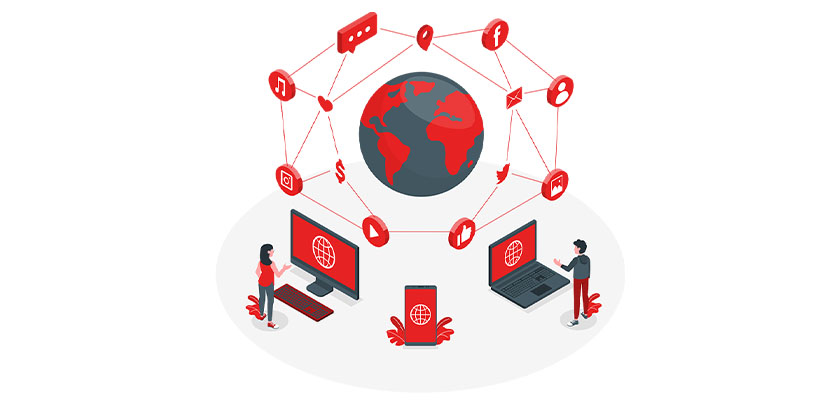
The majority of users on the internet aren’t aware of the magnitude of the system responsible for the transfer of content across the Internet. There are miles of Internet cable between the computer that you’re accessing.
In addition, websites that become well-known must contend with constant growth in monthly traffic, which could make the experience less enjoyable for all parties. Some websites may receive more visitors in a month than comparable sites over the course of a year. Websites that draw a lot of traffic might be forced to deal with frequent server updates to ensure that page speed and, consequently usability, isn’t affected because of their loyal clients. Sometimes, however, easy improvements to the hardware aren’t enough to manage the massive traffic some websites draw. This is exactly where load-balancing algorithms come into the picture. But what is a load balancer, and how does it works?
The question business owners and their UX designers and developers must be asking is not just how to keep the speed of their day at a level that doesn’t compromise usability and also ways to be prepared to handle the type of traffic your website could be exposed to in the future. So, without further ado, let’s discuss what is load balancing in Cloud computing.
What is a Load Balancer, and How Does it Work?
Load balancing is the process of distributing computing workloads among several computers. On the Internet, load balancing can be used to split network traffic between multiple servers. This helps reduce the burden on each server and helps to make servers more efficient, increasing performance and decreasing latency. The ability to balance load is crucial for all Internet applications to function effectively.
Consider a check-out line in the grocery store that has 8 checkout lines, but only one of them is accessible. Every customer must be in the same line; it takes a long time for customers to complete paying for their food items. Imagine that the store is instead open to all eight checkout lines. In this scenario, wait times for customers is around 8 times less (depending on things like the amount of food that the customer is purchasing).
Load balancing is basically doing a similar task. By splitting requests between several servers, wait times are drastically reduced. This improves user experience. For instance, the customers at the grocery store in the previous example are likely to search for a more efficient store if they are always experiencing long waiting times.
What is the Function of a Load Balancer?
Load balancing is performed by an application or tool known as the load balancer. A load balancer could be either software-based or hardware-based. The hardware load balancers need the installation of a separate load-balancing device. Software-based load balancers are run on a server, using a virtual machine or even in the cloud. Content delivery networks (CDN) often include load-balancing features. So in terms of load balancing in networking, it takes effect as a CDN.
When a request comes in from an end user, the load balancer assigns the request to the appropriate server. This process is repeated for each request. The load balancers decide the server that should process each request based on a range of algorithms. The algorithms are classified into two major categories: dynamic and static.
Types of Load Balancers
The concept of load balancing is an important element of highly available infrastructures. According to the requirements of the network, different types of load balancers are used with various storage capacities, functions, capabilities and complexities.
A load balancer may be a tangible appliance or a software instance, or a mixture of both. Two kinds that load balancers can be:
The hardware load balancer: A hardware load balancer is a device that comes with exclusive and customized software specifically designed to handle huge quantities of applications. These load balancers come with an integrated virtualization feature and permit multiple instances of virtual load balancers to be run on one device.
Traditionally, companies loaded proprietary software into hardware dedicated to their customers and then sold it to customers as separate appliances — typically in pairs in order to offer the ability to failover in case one system is down. Expanding networks demand organizations to buy additional or larger appliances.
A load-balancing software: Software load balancing operates in virtual computers (VMs) or white box servers, more likely to be the application delivery controller (ADC) function. ADCs generally offer additional functions such as caching, compression, as well as traffic shaping. In cloud hosting servers, virtual load balancers offer a great deal of flexibility. For instance, it allows users to scale automatically up or down in order to reduce traffic spikes or decrease activities on networks.
Cloud-based load balancers
Cloud load balancing utilizes the cloud as the underlying infrastructure to manage the cloud-based computing environment.
These are some an example of cloud-based load-balancing methods:
Network load balance: This is the most efficient load-balancing method that is available. It works in Layer 4 in the OSI model and makes use of information from the network layer to transfer network traffic.
HTTP Secure load balancing: This allows administrators of networks to allocate traffic based on information that is coming from an HTTP address. It is based on Layer 7 and is among the most flexible load-balancing strategies.
Internal load balance: This is similar to network load balancing, but it is also able to balance traffic distribution within an internal network.
Load Balancing Algorithms
Load-balancing algorithms decide which servers are able to handle specific clients’ requests. There are two kinds of load-balancing algorithms: dynamic and static.
Static load-balancing
This IP hash-based method calculates a client’s preferred server using specified keys, like HTTP headers and IP address data. This technique supports the persistence of sessions, also known as stickiness, which can benefit applications that rely on specific user-stored state information, like checkout carts for online stores.
This round-robin method is used to go through all available servers in order and allocates traffic to the servers in a rotation with the help of DNS. A trusted name server has a list of various “A” records and provides one for every DNS request.
The round-robin, which is a weighted method, allows administrators to assign different weights to each server. In this way, servers that are able to handle more traffic will receive slightly more depending on their weight. The weighting settings are made in DNS records.
Dynamic load-balancing
The lowest-connections technique favors those servers that have the fewest transactions running and is able to send traffic to the servers with the least open connections. This method presumes that all connections will require the same amount of processing power.
It is a method of weighted least connections method based on the assumption that certain servers are better able to handle traffic than other servers. It allows administrators to assign different levels of load to the servers.
This method of weighted responses utilizes the average response times of every server and blends them along with the number of connections each server is able to open to determine the most suitable place to send traffic. This technique will provide faster service since it routes traffic to servers that have the fastest response time.
It is an algorithm based on resources. The algorithm is based on available resources at each server at any given time. Prior to distributing traffic is completed, it calls a special software known as an agent that runs on every server to determine the availability of the central processing unit as well as memory.
The Benefits of Load Balancing
Businesses that have multiple servers could benefit by load-balancing their network traffic. Here are the top benefits that load-balancers offer. Keep in mind that most of the best cloud hosting providers offer load balancing.
Increased scaling: Load balancers can expand the server infrastructure in response to the needs of the network and without impacting services. For instance, the moment a website begins getting a significant number of users, it could result in a sudden increase in traffic. If the website server isn’t equipped to handle the sudden surge of traffic, the site may be unable to keep up with the demand. Load balancing is a way to distribute the increased traffic over multiple servers, thus preventing this from occurring.
Increased effectiveness: Due to the less traffic burden on each server, traffic on the network flows more efficiently and speeds up response times. This, in turn, provides an improved experience for users.
Reducing time to downtime: Companies with a worldwide presence and multiple locations across different time zones could benefit from load balancing, particularly in relation to the maintenance of servers. For instance, a business can shut down a server that is in need of maintenance and then route the traffic to other load balancers, which will not cause disruption to services or interruption in.
Analysis predictive: Load balancing can identify problems early and assist in managing them without affecting other resources. For instance, load balancers that are software-based can identify bottlenecks in traffic before they occur.
Effective Failure management: In the event of a fault, load balancers will instantly redirect users to more functional sources as well as backup alternatives. For instance, if there is a problem with the network, like mail servers, load balancers are able to transfer resources to unaffected areas to avoid disruption of service.
Better security: Load balancers add an additional layer of security without the need for any additional modifications or resources. As more computing shifts to cloud computing, load balancers are equipped with security functions like offloading functions. This helps protect an organization from distributed denial of service attacks by moving attacks from its corporate server to an external cloud provider.
Hardware against. Software load balancers
Both software and hardware load balancers are used in specific situations. Hardware load balancers require rack and stack appliances as well as software load balancers. They are installed on regular x86 servers and cloud instances. VMs, cloud instances or even cloud servers. Hardware load balancers are built to handle high-traffic demands. Software products are usually licensed according to the amount of bandwidth consumed.
Below are the pros and cons of both software and hardware-based load balancers.
Hardware load balancers
Pros
- They can provide high-speed throughput because the software runs on processors that are specifically designed for them.
- They provide greater security because they’re managed solely by the business and not by a third entity.
- They are offered at an agreed price at the moment of purchase.
Cons
- Hardware load balancers need additional personnel and knowledge to configure and program them.
- They aren’t scalable once the limit for several connections has been exceeded. If this happens, the connections are either denied, dropped, degraded or even dropped, and the only alternative is to buy and install additional devices.
- They are more costly since the price of purchasing and maintaining them is greater. A load balancer that is a hardware device may require consultants to handle it.
Software load balancers
Pros
- They can adapt to changing requirements and requirements of networks.
- When you add more software instances, the system will be able to increase the capacity beyond what was initially available.
- Cloud hosting server load balancing offers off-site solutions that operate using a flexible system of servers. Cloud computing can also provide choices with a variety of combinations, like a hybrid with on-site locations. For instance, a company might have its primary load balancer on its premises while an additional load balancer might be hosted in the cloud.
Cons
- When the capacity of your system is exceeded, load balancers from software may create a delay in the initial phase. This is usually the case in the event that the load-balancer software is in the process of being configured.
- Since they do not come with an upfront fixed cost, software load balancers may include ongoing costs for updates.
Conclusion
Many of us depend on internet services that are accessible 24/7. A downtime of 30 minutes for Facebook can cost up to $600,000. In cases of high-traffic websites, load balancing is vital to ensure the reliability and accessibility of the service.
From DNS queries to servers on the web, load balancers can make the difference between expensive interruptions and an effortless user experience.










Leave a Reply